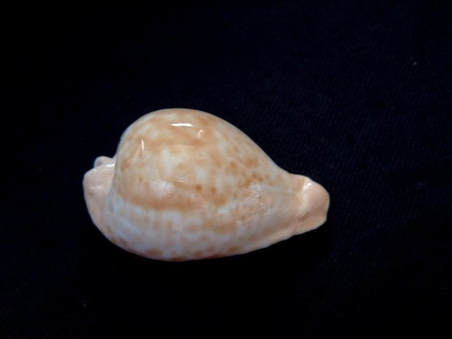Something old, something new: Julian Joseph
"I have been collecting shells for more than 35 years, specialising in
Recent and fossil cowries. Like most collectors, I started with a
general collection, but after a few years I started to concentrate on
one family, the Cypraeidae. After doing an undergraduate research
project on the evolution of this group of molluscs (against the advice
of my tutor, who though the subject was far too specialised), I became
interested in the fossil species as well."

Bernaya teulerei (Cazenavette 1846) 38mm from Oman. A "living
fossil", and the first uncommon cowrie I ever acquired. The only living
species of the genus Bernaya, which is one of the most ancient Cypraeid
genera, with numerous fossil species.

Siphoncypraea mus (Linnaeus, 1758) 57mm from Venezuela. An
unusually large, dark specimen with a prominent, spoon-shaped anterior
extremity. Another "living fossil", closely related to the common fossil
species of Florida.

Siphocypraea hertweckorum Petuch, 1991 from Sarasota, Florida and S. mus (Linnaeus 1758) f bicornis (Sowerby 1870) from Amuay Bay, Venezuela. This specimen of S. hertweckorum (67mm) is a nearly "gem" Pliocene fossil; S. mus (61mm) is its closest living relative, bicornis being the tuberculate form.

Barycypraea fultoni massieri Lorenz, 1991 60mm from Southern Mozambique and B. caputviperae
Martin, 1899 45mm West Java.
A "living fossil" and a "real" one! This specimen of B. fultoni massieri is
very small, only 1mm more than the minimum size for this form. Luckily
the sand grains in the specimen don't show in the photograph. B.
caputviperae is a fossil representative of this genus, which was once
common in Indonesia but is now confined to a single species off south-eastern Africa. It is interesting to note that the two living
species of Coelacanth fishes also occur off south-east Africa and Indonesia
only.

Zoila decipiens f. suprasinum Lorenz, 2002 58mm from Onslow, NW Australia.
The southern subspecies of Z. decipiens described by Felix Lorenz in 2002. It is larger, heavier and slightly darker than the nominate form from Broome.

Leporicypraea mappa Linne, 1758 form aliwalensis Lorenz, 2000 69mm from Aliwal Shoal, Natal, South Africa and Mauritia arabica immanis Schilder & Schilder, 1939 79mm from South Africa .
This dark, elongate specimen of arabica immanis looks remarkably like mappa aliwalensis but is only distantly related!

Erosaria guttata (Gmelin, 1791) 57mm.
I thought this was form azumai when I got it from Japan but it isn't! It is almost certainly a Philippine specimen, but has no locality data .

Austrocypraea reevei (Sowerby, 1832) 36mm from Albany, Western
Australia.
A quite slender and dark specimen. The only surviving member of the
genus Austrocypraea, which has numerous fossil species in Australia.

Umbilia capricornica Lorenz, 2000 65mm from Australia.
I acquired this in Taiwan. The dorsal pattern is like that of hesitata beddomei, but the base is that of capricornica.

Cypraeovula castanea (Higgins, 1963) 39mm from Jeffreys Bay, South
Africa.
Rarely seen in good condition, this dead-collected specimen has at least
some colour and gloss – most specimens are bleached white and eroded.
